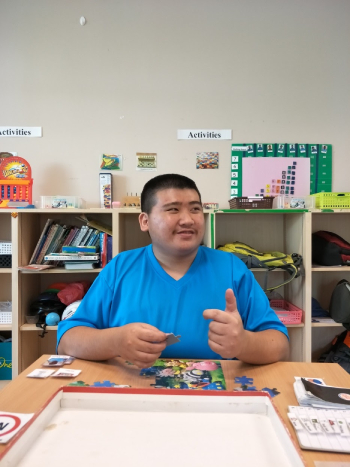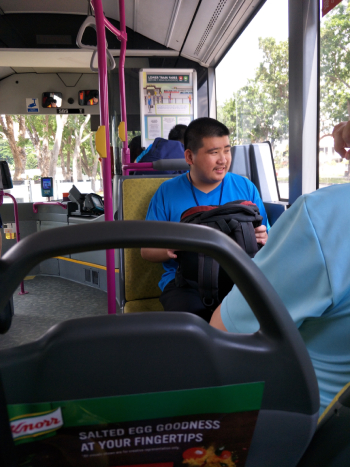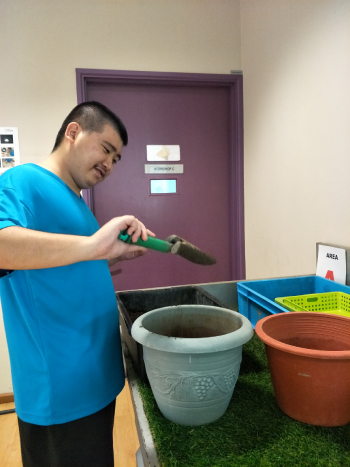Adult Years in St. Andrew’s Day Activity Centre
In this second instalment of our short trilogy of stories, we continue with Xuan’s journey young adulthood. Thank you for tuning in.
 Starting Anew
Starting Anew
“Looks like we’re not able to head out again today,” Coach Eve said to her teammates as she watched Xuan meltdown by slamming himself. This time, in reaction to the heat. Guiding Xuan back to the air-conditioned classroom, she had encouraged him to work on another activity, but with little success as Xuan had started becoming fixated on arranging the visual cues on his table.
Clearly, this relentless organising was Xuan’s way of self-regulating his frustrations and anxieties in the new environment of the Day Activity Centre (DAC) at St. Andrew’s. Unfortunately, his attempts were short-lived. Despite making some headway, he was quickly disrupted by his noisy classmate seated nearby.
Anxiety mounted. Agitations increased.
The next thing we know, Xuan was hitting himself hard with his palm. As Coach Eve moved quickly to stop him from self-injury, the rest of her team managed to calm the noisy classmate, and Xuan.
Stepping into the classroom the next day, Xuan plopped himself at his desk chair and began to look around. It had been his first few weeks at the DAC after graduating from St. Andrew’s Autism School. Everything in the classroom was structured differently from what he had been used to at school. Even the tasks he was assigned with seemed slightly different as well.
There were no longer the familiar faces of his teachers; faces he had grown attached to for the years he spent at school. Rather, he was encountering new faces and new names that he had to adjust and adapt to, and form new relationships with. “Adulting” has begun for Xuan in the DAC.
 Adulting at the DAC
Adulting at the DAC
Transition periods can be a painful period for new DAC clients. Understanding this, DAC coaches team up with psychologists and clients’ caregivers to dialogue and share information about each client’s growth point and behavioural issues, as well as work out strategies to help our adults on the autism spectrum grow, learn and overcome.
Continuing from the good work at the school level, the DAC focuses on further developing clients’ daily living skills and improving their overall well-being. Additionally, clients’ social interaction skills are strengthened with more emphasis on planned community outings on public transport and purchasing from nearby supermarkets. Depending on clients’ abilities, the 6-hour daily programme would also identify suitable pre-vocational or vocational skills in various interest areas, and help them slowly grow in those skills.
 Quite unlike the outings at the school that either tended to take place in the mornings, or with private transportation, outings at the DAC took the form of weekly lunch out in the community. That meant, at a time when it was the hottest. So, even a short walk to have lunch at a nearby coffee shop demanded a lot from Xuan due to his low tolerance for heat. “In my experience with him, he was usually passive and did not want to participate in class activities. He would get aggressive when he was not able to regulate his emotions, or get what he wanted. He was also affected by too much noise, which is why we refrained from repeating instructions too many times. Rather, we would nudge him with prompts,” recalled Coach Eve.
Quite unlike the outings at the school that either tended to take place in the mornings, or with private transportation, outings at the DAC took the form of weekly lunch out in the community. That meant, at a time when it was the hottest. So, even a short walk to have lunch at a nearby coffee shop demanded a lot from Xuan due to his low tolerance for heat. “In my experience with him, he was usually passive and did not want to participate in class activities. He would get aggressive when he was not able to regulate his emotions, or get what he wanted. He was also affected by too much noise, which is why we refrained from repeating instructions too many times. Rather, we would nudge him with prompts,” recalled Coach Eve.
At the DACs, Xuan’s meltdowns were usually caused by interruptions to routines, accentuated by his tendency to rigidity. Unlike the school where service hours were four hours daily, the programme at the DAC was six hours daily. That in itself, meant reorganising routines and time allotted for tasks and activities. Appreciating that Xuan’s anxiety levels are tied to the completion of tasks in the schedule, Coach Eve and her team reworked his routines so that they were shorter and simpler to follow.
To prevent him from being preoccupied with arranging, they changed his physical environment and situated his work desk away from his classmates. A clear desk with the usual visual prompts and schedules moved out of sight provided a conducive environment for focus, and minimised his rigidity.
Understanding his low tolerance of heat helped Coach Eve and her team to come up with various measures for him to regulate himself when he is perturbed by it. From wiping his face with a wet wipe to changing his t-shirt, they were able to progress from being confined to exercise facilities in the classroom to exercising at a park connector, which is a five-minute walk from SAAC.
 To manage his weight, a side effect of the epileptic medication he was on, Coach Basti, who later took on Xuan in his class, got him started on the treadmill at the Centre, and stretched him further in life skills development with tasks such as watering plants in the small garden at the class’ balcony. Over time, Xuan, ever the earnest learner, managed to cope better with the heat, and adapted to new ways of self-regulation. As a class, they were also by then, able to go further away for community lunch and outings. There were days when they ventured as far as to the hawker centre at East Coast Park for lunch!
To manage his weight, a side effect of the epileptic medication he was on, Coach Basti, who later took on Xuan in his class, got him started on the treadmill at the Centre, and stretched him further in life skills development with tasks such as watering plants in the small garden at the class’ balcony. Over time, Xuan, ever the earnest learner, managed to cope better with the heat, and adapted to new ways of self-regulation. As a class, they were also by then, able to go further away for community lunch and outings. There were days when they ventured as far as to the hawker centre at East Coast Park for lunch!
Those were such fun times. Xuan’s minute strides meant more opportunities were opened to the class to explore different types of outings. And the icing on the cake? Well, affirmation and little acts of kindness from the public. As Coach Basti recounted, “We even have the drinks uncle supply them (the clients and accompanying coaches) with sugarcane juice when we dine over at the hawker centre sometimes,” recalled Basti. Heartwarming indeed.
 Xuan as an adult, developed more life skills, and even got to enjoy a walk and a meal at a hawker centre often. His world has expanded from beyond his own space into a much bigger space in the community.
Xuan as an adult, developed more life skills, and even got to enjoy a walk and a meal at a hawker centre often. His world has expanded from beyond his own space into a much bigger space in the community.
With no additional support other than the help and relief provided from social service agencies, the caregiving of Xuan fell mainly on his mother, while his father brought bread to the table. The pressure of caregiving, social stigma and financial strains from consecutive job retrenchments brought the parents through much difficult times.
As Xuan’s behaviour improved with the help of DAC coaches, and he grew in more confidence and independence, it was time for the parents who had been exhausted over the many years of support through his growing up years, to find time and space to heal.
About Sensory Integration
By Ms Eve Lee, Psychologist at St. Andrew’s Adult Home (Sengkang). Eve was also Xuan’s former DAC Coach.
Persons with autism commonly experience sensory integration challenges which may be presented
as hypersensitivity or hyposensitivity to environmental stimuli. This can be observed through an
individual’s acute sensitivity to noise (auditory), heat (tactile), or lights/colours (visual).
In Xie Xuan’s case, brief exposure to heat may be intolerable. Coupled with poor
communication skill, Xie Xuan would have difficulty expressing what is causing his extreme discomfort, and his frustration could be expressed through self-injurious behaviour (i.e. hitting self) and/or behaviours of aggression (i.e., hitting out towards others).
A common intervention for such cases would be to equip the child/adult with communication skills with the use of visuals, technological equipment (i.e. IPAD), or gestural communication/signing.
Where training Xie Xuan in the use of visual communication is concerned, there is a second layer of challenge to surmount. As with many persons with autism, inflexibility and rigidity are common traits. An individual with rigidity may require specific items in the environment to be arranged or fixed in a specific manner. He/she may attempt to arrange the item/stimuli until it is adjusted accordingly. This applies to Xuan. When given visuals, Xuan would arrange and press the corners of the visuals for extended period of time. This fixation interferes the communication training and further challenges communication.
Inflexibility may present itself in different forms as well; the need to follow specific routine (not able to accept even slight changes), being able to eat only certain types of food, and/or ability to transit from preferred activities to other activities.
In managing Xuan’s rigidity, besides redirecting him to appropriate task(s) and changing the physical environment, what is needed is patience to consistently work with him through this intervention. For challenges with sensory needs, Xuan is provided with materials to manage his sensitivity to heat and noise, and teaching him to be independent to manage his needs. After working with Xuan for three to five years, we have seen improvements. Although Xuan is still not able to independently manage his rigidity and sensory needs, he is much more adjusted and is able to cope with the daily demands.
Read the last part of Xie Xuan’s story here: https://www.saac.org.sg/2020/11/04/journey-in-a-lifespan-3/
Journey In A Lifespan






